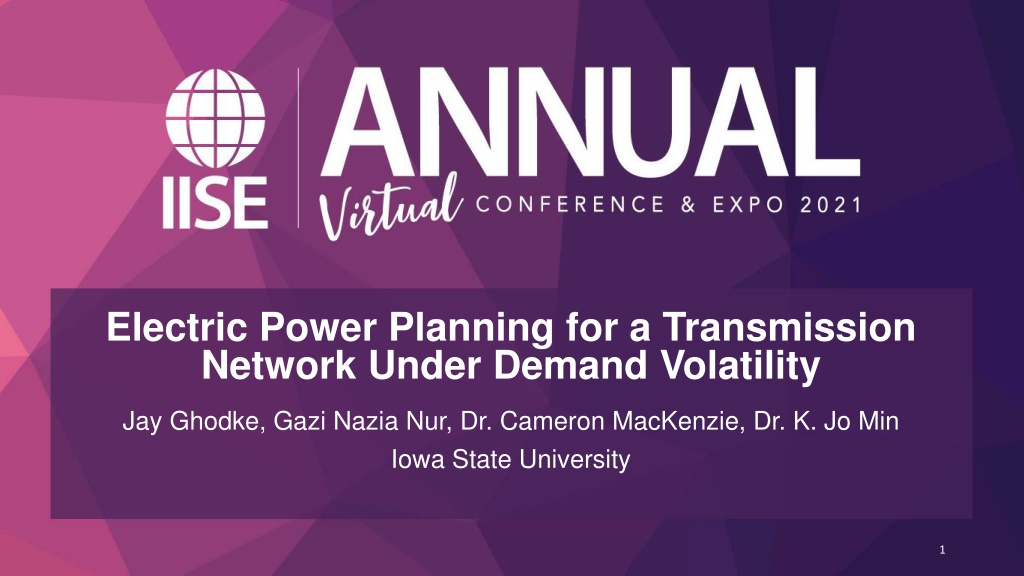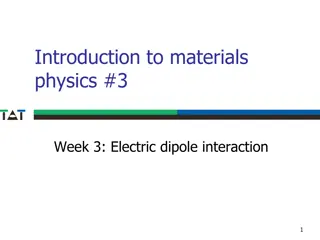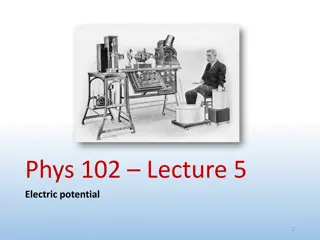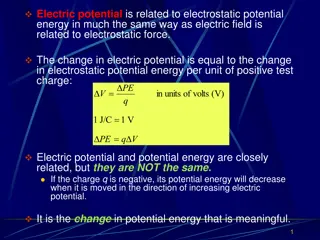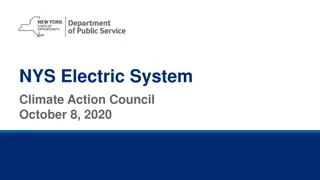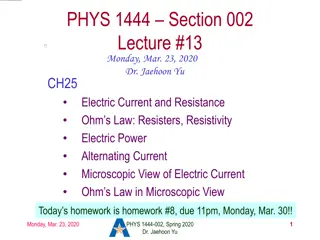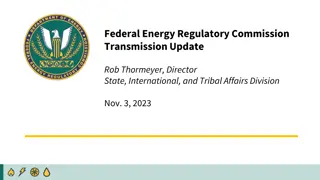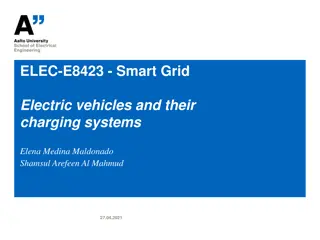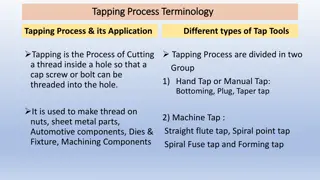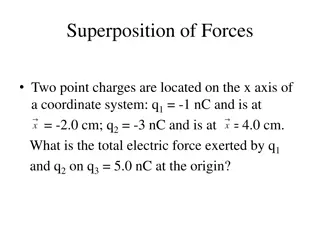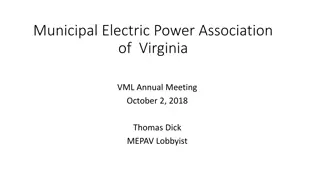Electric Power Planning for Transmission Networks: Real Options Approach
The study explores evaluating the option value of expanding transmission lines using a Real Options approach. It involves DCOPF calculations to determine locational marginal prices (LMPs) and uses a Binomial Lattice to assess uncertain demand scenarios. The analysis includes adding new generators and evaluating the option of adding a new transmission line as an alternative. Optimizing power flow models are discussed to understand the impact of network modifications on power generation and distribution.
Download Presentation

Please find below an Image/Link to download the presentation.
The content on the website is provided AS IS for your information and personal use only. It may not be sold, licensed, or shared on other websites without obtaining consent from the author. Download presentation by click this link. If you encounter any issues during the download, it is possible that the publisher has removed the file from their server.
E N D
Presentation Transcript
Electric Power Planning for a Transmission Network Under Demand Volatility Jay Ghodke, Gazi Nazia Nur, Dr. Cameron MacKenzie, Dr. K. Jo Min Iowa State University 1
Objective Objective Evaluating the option value of expanding the existing transmission line using Real Options approach DCOPF is calculated to obtain LMP values for all buses Binomial Lattice is constructed to map the uncertain demand In part one, a new generator will be added to the network In second part the option value of adding a new transmission line is evaluated as an alternative to a new generator 2
Adding A New Generator to the Adding A New Generator to the Network Network 3
Optimal Power Flow (OPF) Optimal Power Flow (OPF) There are 2 generators in bus 2 and 3. The generator at bus 1 is not available currently We will discuss the consequence of adding one generator at bus 1 Three bus network model 4
Optimal Power Flow (OPF) Optimal Power Flow (OPF) Case 1: Bus 1 will have no generator and the demand at this node will be satisfied by generators 2 and/or 3 Case 2: We will add a generator at bus 1 and the total demand will be met by the combination of all three generators 5
Optimal Power Flow (OPF) (Case 1) Optimal Power Flow (OPF) (Case 1) Susceptance Matrix [??] = Minimize (7.85*G2 + 7.97*G3) 1800 ?1 1000 ?2 800 ?3+ 200 = 0 1000 ?1+ 1500 ?2 500 ?3 ?2+ 550 = 0 800 ?1 500 ?2+ 1300 ?3 ?2+ 100 = 0 ?1= 0 1000 ?1 1000 ?2<= 210; 1000 ?2 1000 ?1<= 210 ?? = generation quantity at node i ; ?? = phase angle for node i 6
OPF OPF - - Solving and Finding LMP values (case 1) Solving and Finding LMP values (case 1) G3 = 0 MW Output for case 1: LMP3 = $7.85/MWh value of ?2 = 850 MW value of ?3 = 0 MW value of ?1 = 0 MW value of ?2 = 0.2 value of ?3 = 0 100 MW L3 = 100 MW LMP1 = $7.85/MWh 200 MW G2 = 850 MW (210 MW) L1 = 200 MW LMP2 = $7.85/MWh L2 = 550 MW 7
Optimal Power Flow (OPF) (Case 2) Optimal Power Flow (OPF) (Case 2) Minimize (7.92*G1 + 7.85*G2 + 7.97*G3) 1800 ?1 1000 ?2 800 ?3 ?1+ 200 = 0 1000 ?1+ 1500 ?2 500 ?3 ?2+ 550 = 0 800 ?1 500 ?2+ 1300 ?3 ?2+ 100 = 0 ?1= 0 1000 ?1 1000 ?2<= 210; 1000 ?2 1000 ?1<= 210 8
OPF OPF - - Solving and Finding LMP values (case 2) Solving and Finding LMP values (case 2) G3 = 0 MW Output for case 2: LMP3 = $7.85/MWh value of ?1 = 0 MW value of ?2 = 850 MW value of ?3 = 0 MW value of ?1 = 0 MW value of ?2 = 0.2 value of ?3 = 0 G1 = 0 MW 100 MW LMP1 = $7.85/MWh L3 = 100 MW 200 MW G2 = 850 MW (210 MW) L1 = 200 MW LMP2 = $7.85/MWh L2 = 550 MW 9
Demand Evolution at bus 1 for one time step Demand Evolution at bus 1 for one time step Risk free discount rate (rf)= 4.879% per annum compounded continuously Volatility ( ) = 30%/year Time step ( t) = 1 year; Total time frame = 1 year Up-factor (u) = e t=1.35 Down factor (d) = 1/u = 0.741 Initial demand at bus 1 (D)= 200 MW Up demand = u x D; Down demand = d x D Risk-neutral probability, q= (erf-d)/(u-d) = 0.5074 270 200 148.2 Time 0 Time 1 Demand lattice (in MW) 10
OPF OPF - - Solving and Finding LMP values Solving and Finding LMP values Case 1: Without generator 1 Load at bus 1 (MW) LMP at bus 1 ($/MWh) LMP at bus 2 ($/MWh) LMP at bus 3 ($/MWh) 200 7.85 7.85 7.85 270 8.045 7.85 7.97 148.2 7.85 7.85 7.85 Case 2: With generator 1 Load at bus 1 (MW) LMP at bus 1 ($/MWh) LMP at bus 2 ($/MWh) LMP at bus 3 ($/MWh) 200 7.85 7.85 7.85 270 7.92 7.85 7.893 148.2 7.85 7.85 7.85 11
Cost paid by the community at bus 1 (Case 1) Cost paid by the community at bus 1 (Case 1) When the demand at bus 1 is 270 MW, locational marginal price at bus 1 is $8.045 For other nodes, the locational marginal price is $7.85 Cost= LMP x load at bus 1 x 8760 19.028 13.75 10.19 Cost lattice for case 1 (in $ millions) 12
Cost paid by the community at bus 1 (Case 2) Cost paid by the community at bus 1 (Case 2) When the demand at bus 1 is 270 MW, locational marginal price at bus 1 is $7.92 For other nodes, the locational marginal price is $7.85 Cost= LMP x load at bus 1 x 8760 18.732 13.75 10.19 Cost lattice for case 2 (in $ millions) 13
Net benefit Net benefit We can calculate the net benefit by subtracting the mentioned in previous two slides That is the amount of monetary benefit we get for adding a generator 0.296 two costs 0 0 Net benefit lattice (in $ millions) 14
Option value tree Option value tree The generator is added to the network after one year after knowing the demand at time 1 The call option is European The option value: (0.196 0.5074 + 0 0.4926) ? 0.04879 = $0.0947 million 0.196 0.0947 0 Option value tree (in $ millions) 15
Results & Discussion Results & Discussion The value of adding a new generator is $94,700 Exercising this option is beneficial only when the demand is 270 MW in our case Another alternative to adding a generator is adding a transmission line to the network Future research includes comparison of these two options 16
Adding A New Transmission Line Adding A New Transmission Line Parallel to Line 1 Parallel to Line 1- -2 2 17
The Process to Derive the Option Value The Process to Derive the Option Value The susceptance matrix [??] is recalculated The LMP values are obtained from the new DCOPF The net benefit lattice is constructed using the binomial lattice structure The option value is calculated using risk neutral probability 18
Network Model Network Model Reactance Line 1-2 = 0.1 PU Line 1 -2 = 0.1 PU Line 2-3 = 0.2 PU Line 1-3 = 0.125 PU 19
Susceptance matrix Susceptance matrix The susceptance matrix [??] will be changed as follows [??] = ?12= 0.1 PU when there is single transmission line But ?12 = 0.2 PU for two parallel transmission lines by assuming 1-2 and 1 -2 as a single equivalent line 20
Case 1 Case 1 Without a new transmission line 1 -2 The programmed on Excel Solver The sensitivity report of the solution gives the LMP values DCOPF problem is 21
Case 2 Case 2 With a new transmission line 1 -2 The LMP values change and are same for all the buses 22
Demand Evolution at Bus 1 Demand Evolution at Bus 1 270 We construct binomial lattice model to forecast the demand for one time step (1 year) We assume that electricity demand follows GBM Demand is 200 MW at node 1 at time = 0 and it can rise to 270 MW or drop to 148.2 MW at time = 1 200 148.2 Time 0 Time 1 Demand lattice (in MW) 23
Economic Consequence Economic Consequence Case 1 Case 1 When the load = 270 MW at bus 1, LMP is 8.045 $/MWh Bus 1 community pays $19.028 million in a year when load = 270 MW 19.028 13.75 $ 8.045 ?? 8760 ?? 270 ?? = $19,028,034 10.19 Cost lattice for case 1 (in $ millions) 24
Economic Consequence Economic Consequence Case 2 Case 2 When the load = 270 MW at bus 1, LMP is 7.85 $/MWh Bus 1 community pays $18.56 million in a year when load = 270 MW 18.56 13.75 $ 7.85 ?? 8760 ?? 270 ?? = $18,566,820 10.19 Cost lattice for case 2 (in $ millions) 25
Net Benefit Lattice Net Benefit Lattice 461,214 0 The net benefit for any time point is the difference between the costs which is $461,214 We assume that the total construction cost of a transmission line 1 -2 is $100,000 The net benefit lattice after paying the total construction cost can be attained by simply subtracting the total construction cost from the net benefit The decision to build a transmission line is taken before knowing the future demand 0 361,214 0 -100,00 Net benefit lattice (in $) 26
Option value tree Option value tree A new transmission line is added to the network after one year after knowing the demand at time 1 The call option is European The option value is: (361,214 0.5074 100000 0.4926) ? 0.04879 = $ ???,???.?? 361,214 ???,??? 0 Option value tree (in $) 27
Results & Discussion Results & Discussion (Recall back to slide 16) The value of the option of adding a new transmission line is superior to adding a new generator to bus 1 The option value of adding a new generator is $94,700 The benefit for the whole grid is higher than that for the bus 1 community only This is due to reduced LMP at bus 3 28
Future Research Future Research Including the power losses in the OPF calculation will increase the practicality of the model Considering the accurate cost of transmission line, O&M costs, and the length of the line in the calculation will make the option value more appropriate To improve the accuracy of the model, the binomial lattice model can be increased up to 20 years 29
Thank You! Thank You! 30
